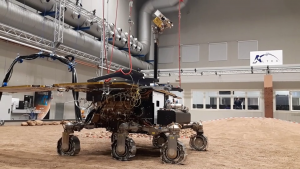Both agencies have signed a new Memorandum of Understanding (MoU) to include important US contributions, such as the launch service, elements of the propulsion system needed for landing on Mars, and heater units for the Rosalind Franklin rover.
The mission, which is due to launch in 2028, will search for past and present signs of life on Mars.
Two years ago, due to the Russian invasion of Ukraine, ESA discontinued its cooperation with the Russian space agency Roscosmos.
The ESA writes:
“Besides the launch service and throttleable braking engines, the main update is that NASA in partnership with US Department of Energy (DOE) will provide the lightweight radioisotope heater units (RHUs) for the rover. Led by the UK, work on the development and certification of a European RHU to fly on the mission will continue in parallel. The ESA GSTP/ENDURE programme (ENDURE standing for ‘European Devices Using Radioisotope Energy’) will deliver an end-to-end European capability for radioisotope heat and power systems by the end of this decade.”
The Rosalind Franklin mission’s next milestone will a system preliminary design review for the rover, which is taking place in June 2024.
“This pivotal agreement strengthens our collaborative efforts for the ExoMars programme and ensures that the Rosalind Franklin rover will set its wheels on martian soil in 2030,” said Daniel Neuenschwander, ESA’s Director of Human and Robotic Exploration. Along with NASA’s Associate Administrator for the Science Mission Directorate, Nicola Fox, he signed the agreement at ESA’s headquarters in Paris, France.
“The Rosalind Franklin rover’s unique drilling capabilities and onboard samples laboratory have outstanding scientific value for humanity’s search for evidence of past life on Mars,” said Fox. “NASA supports the Rosalind Franklin mission to continue the strong partnership between the United States and Europe to explore the unknown in our solar system and beyond.”
Pictured above is a replica ExoMars at the Mars Terrain Simulator at ALTEC, in Turin. The Ground Test Model (GTM) will be used in the Rover Operations Control Centre to help support future mission training and operations.
The rover has been developed by Airbus UK.
See also: Phlux APDs to boost ESA satcomms
 Electronics Weekly Electronics Design & Components Tech News
Electronics Weekly Electronics Design & Components Tech News




